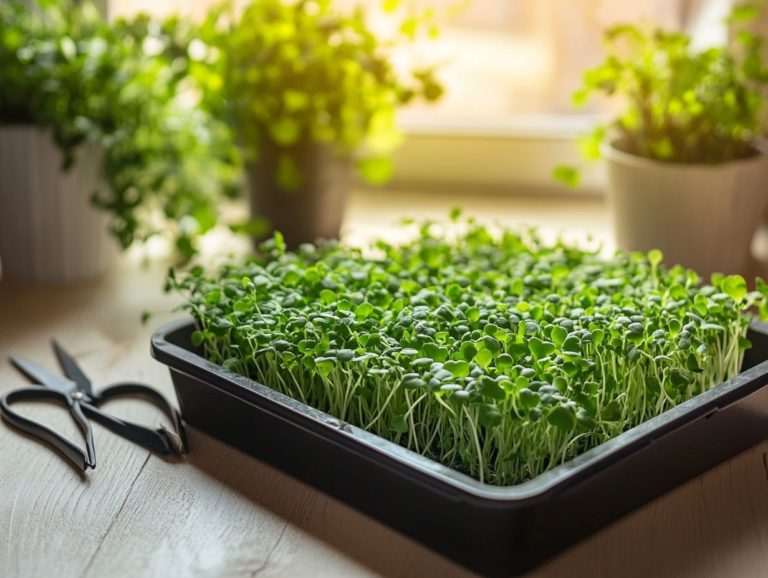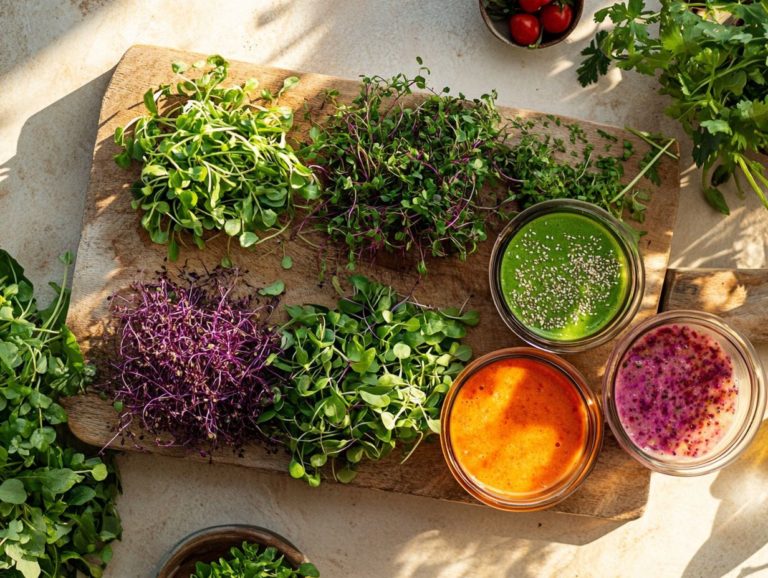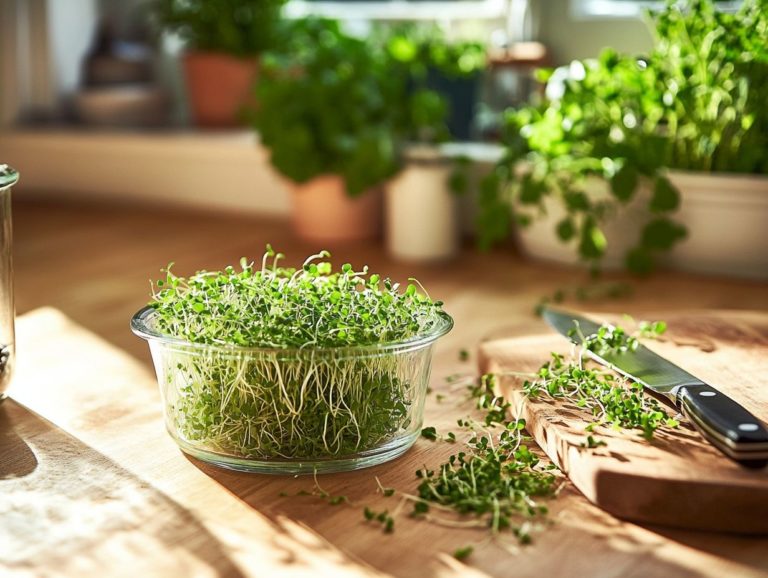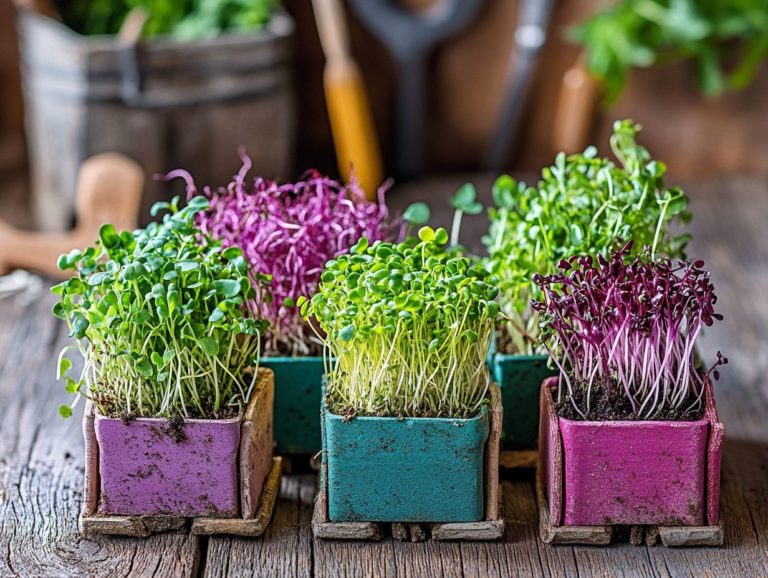How Often to Harvest Microgreens
Microgreens are delightful little powerhouses of nutrition that have taken the culinary world by storm. They elevate the flavor of your dishes and are remarkably simple to cultivate right in your kitchen.
This article explores the benefits of growing and harvesting microgreens, highlighting their impressive nutritional profile and convenience. It discusses the factors influencing harvest frequency, provides guidelines for popular varieties, and outlines an efficient step-by-step guide for harvesting.
You ll also find tips to maximize both the yield and quality of your microgreen garden, ensuring you truly make the most of this rewarding endeavor.
Contents
Key Takeaways:
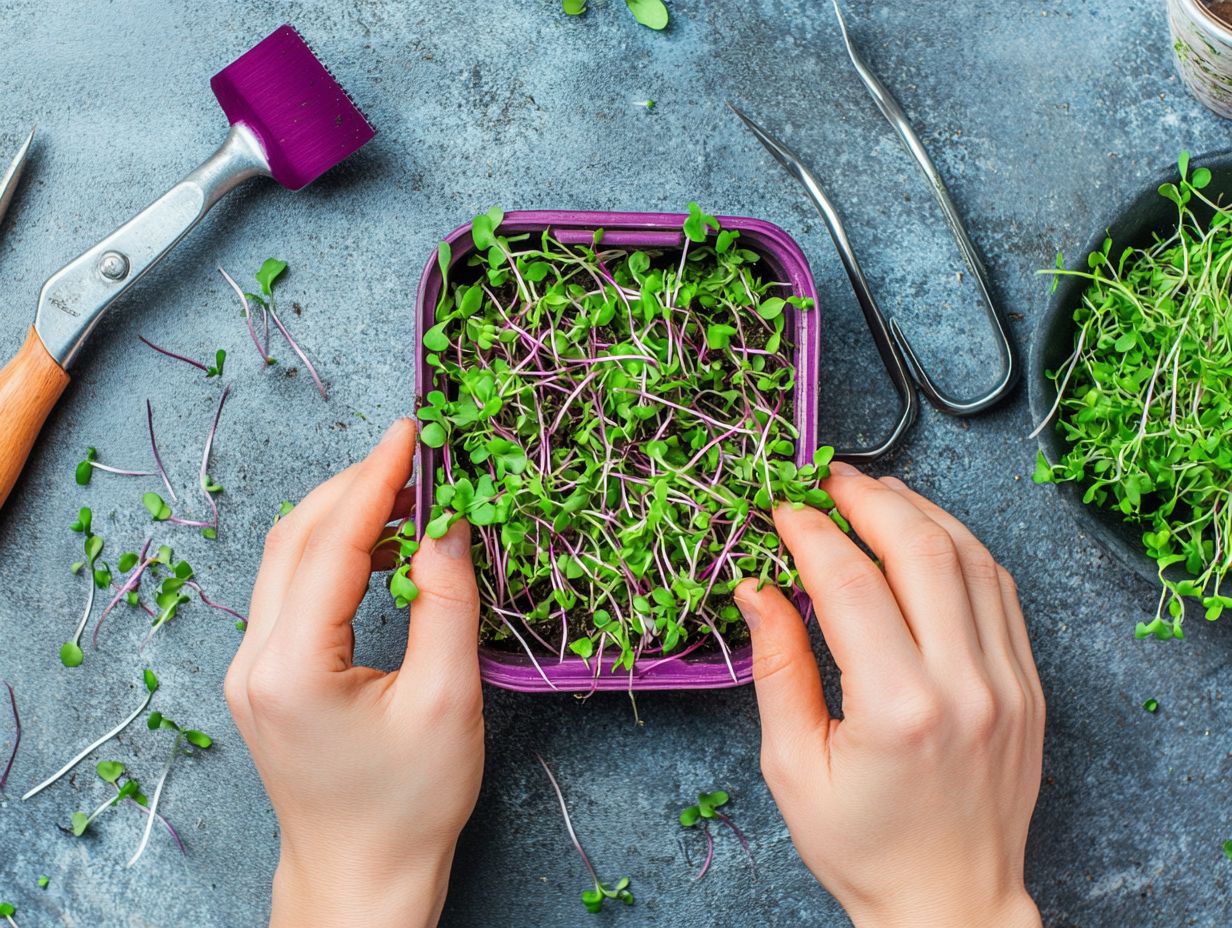
- Harvest microgreens at the right time for the best taste and nutrition.
- Consider growth cycles and conditions to know when to harvest.
- Follow specific guidelines for popular varieties to get the most out of your garden.
What are Microgreens?
Microgreens are tiny edible plants you can harvest shortly after they germinate. They showcase the first leaves that appear after germination, called cotyledons, and the subsequent leaves, known as true leaves. These nutritional powerhouses like broccoli, cauliflower, arugula, and basil thrive in small spaces and have captured the hearts of urban gardeners everywhere.
They re not just easy to grow; they add a fresh burst of flavor that can elevate any dish, making them essential in salads and a variety of culinary creations.
In recent years, the popularity of microgreens has skyrocketed, thanks to their intense flavor profiles and impressive health benefits, which include high concentrations of vitamins, minerals, and antioxidants. Often dubbed ‘superfoods,’ they come in various types, from zesty radish microgreens to delicate sunflower shoots. Culinary enthusiasts love using microgreens as garnishes, adding a pop of color and taste to their plates.
Growing microgreens indoors is straightforward, making it accessible even for those new to gardening. Germination typically takes just a week or two. With their charming aesthetic and myriad health advantages, microgreens truly shine in both home kitchens and professional culinary settings. To enhance your microgreen experience, learn how to harvest popular microgreen varieties.
Benefits of Growing and Harvesting Microgreens
Growing and harvesting microgreens presents benefits that enhance your gardening experience. With their better nutrition, vibrant flavors, and easy cultivation, it’s easy to see why they re so popular!
The compact nature of microgreens optimizes space, whether you’re tending to a backyard plot or utilizing an urban balcony. This means you can enjoy fresh, homegrown produce all year round with minimal effort, especially when you know the best time of day to harvest microgreens.
Nutritional Value and Convenience
Microgreens are your secret weapon for elevating nutrition, brimming with concentrated vitamins and minerals that significantly enhance your diet while delivering a delightful burst of fresh flavor. Their ease of cultivation requiring minimal space and resources makes them the perfect choice for urban gardeners or anyone new to gardening.
These tiny powerhouses are rich in essential nutrients, including vitamins C, E, K, and a spectrum of B vitamins, paired with vital minerals like calcium, magnesium, and iron. Packed with antioxidants, they bolster immune function and play a crucial role in reducing inflammation.
Whether you grow them in small containers on your windowsill or balcony, harvesting microgreens is a breeze, allowing you to effortlessly add fresh greens to your meals.
With their versatility and numerous health benefits, microgreens provide an accessible way for you to boost your nutrition today!
Factors to Consider for Harvesting Frequency
Regarding harvesting microgreens, several key factors demand your attention, including the specific stage of growth, germination rate, and best growing conditions.
Grasping these elements is essential for maximizing both yield and flavor in each harvest. This knowledge gives urban gardeners like you the power to savor the freshest produce while ensuring the health of your microgreen crops remains intact. After harvest, it’s important to know what to do with microgreens to make the most of your crop.
Growth Cycle and Plant Variety
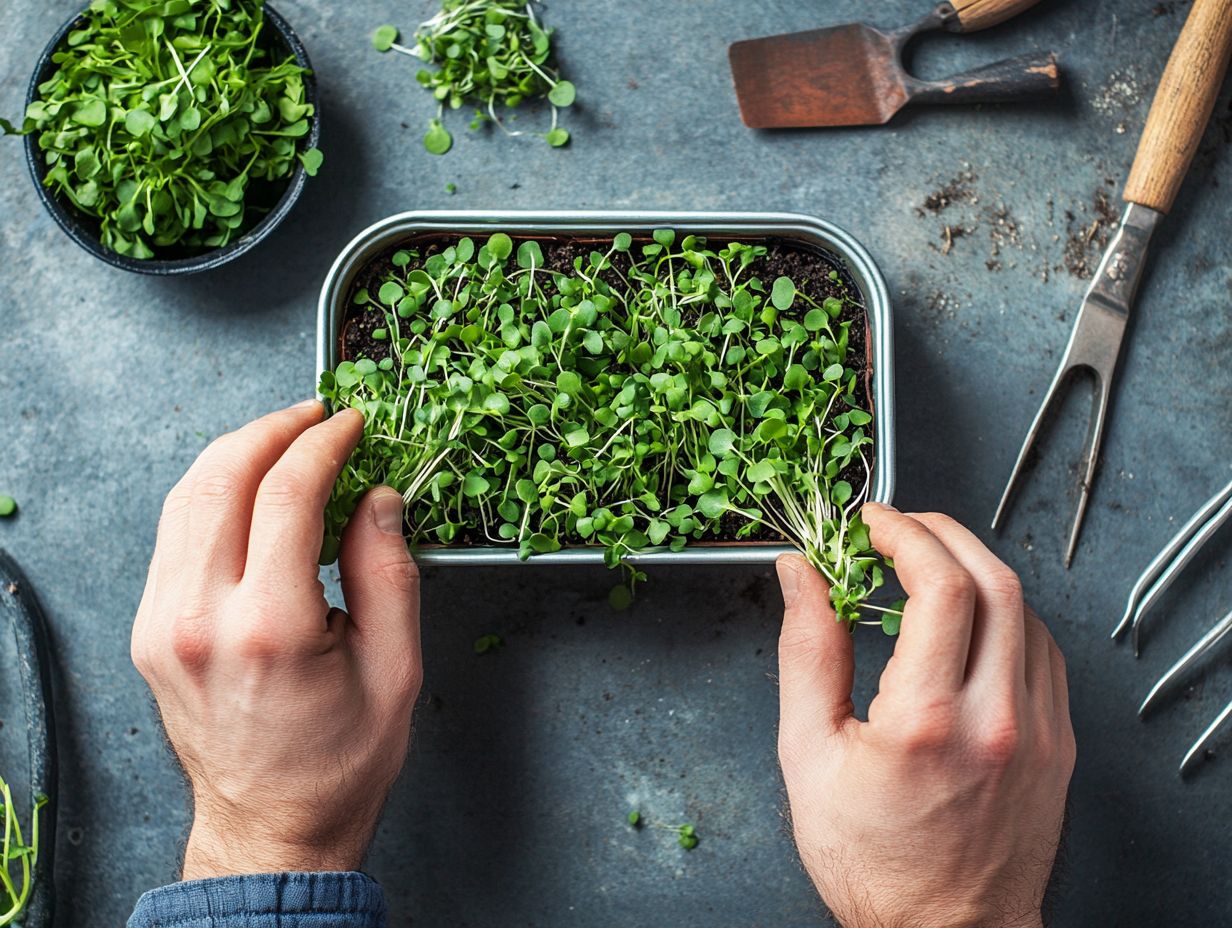
The growth cycle of microgreens can vary greatly based on the variety you choose. Some, like basil and arugula, shoot up quickly, while others may take their sweet time to develop their distinct flavors and textures. Grasping the nuances of these different microgreen varieties allows you to plan your planting schedules effectively, optimizing both your yields and culinary possibilities.
Take radish microgreens, for example they typically sprout in just five to seven days, adding a delightful spicy crunch to your salads and sandwiches. In contrast, slower-growing varieties like sunflower seeds might take up to 14 days, but they reward you with a nutty flavor that complements a multitude of dishes. To learn more about their growth patterns, check out our guide on understanding microgreen growth cycles.
Pay close attention to growing factors for successful cultivation! Factors like light exposure and watering routines are crucial. Basil, for instance, flourishes in warmer conditions with plenty of sunlight, while leafy varieties such as kale prefer a cooler environment. Additionally, knowing how to harvest microgreens without damaging them can enhance your culinary experience. By customizing your planting approach based on these growth cycles and flavor profiles, you can craft vibrant, fresh dishes that truly showcase the unique contributions of each microgreen variety.
Environmental Factors
Environmental factors are important for growing microgreens well, encompassing the right growing conditions, adequate sunlight exposure, and a consistent watering schedule. Mastering the balance of these elements is essential for you as an urban gardener to achieve optimal results, whether you’re growing microgreens indoors or outdoors.
Optimizing light conditions is essential; these greens thrive under bright, indirect sunlight or with artificial grow lights that replicate natural patterns. While microgreens crave moisture, too much water can drown them; this is known as waterlogging, so maintaining a balanced watering schedule is crucial. For those looking to perfect their technique, microgreen harvesting: a step-by-step guide can provide valuable insights. Soil conditions also play a significant role; a well-draining potting mix rich in nutrients will support vigorous growth.
If you’re managing an indoor setup, consider employing a moisture meter and rotating your crops to ensure they receive even access to light and moisture. By fine-tuning these environmental factors, you can significantly enhance both the yield and quality of your microgreens. Additionally, learning how to properly harvest microgreens for maximum flavor can further improve your results.
Recommended Harvesting Frequency for Different Microgreens
The ideal harvesting frequency varies among different microgreens varieties, with most reaching the perfect cutting height above soil within 7 to 21 days after germination, depending on the specific type.
By grasping these timelines, you can plan your harvests with precision, ensuring that you savor the peak freshness and flavor of your greens.
Specific Guidelines for Popular Varieties
Specific guidelines for harvesting popular microgreens like cilantro, buckwheat, and chives give urban gardeners the power to reap their health benefits at peak freshness. Each variety boasts its own growth pattern and flavor profile, calling for tailored harvesting techniques.
For example, cilantro is primed for harvest when it reaches about 4-5 inches tall; remember to cut just above the soil line to encourage that delightful regrowth. Buckwheat, with its enticing nutty flavor, should be snipped when it sprouts small, delicate leaves, typically around 1-2 weeks after sowing. As for chives, known for their mild onion taste, you can begin harvesting once they grow to about 6 inches, allowing for multiple cuttings throughout their growing cycle. For more detailed insights, check out understanding microgreen harvest timing.
After cutting, gently rinse your microgreens under cool water to remove any soil residues. Pat them dry with a clean towel before storing them in an airtight container in the refrigerator to keep them fresh and vibrant.
How to Harvest Microgreens
Harvesting microgreens demands your keen attention to detail. Cut just above the soil line using clean scissors, and wash the ends thoroughly.
This meticulous approach is crucial for maintaining the freshness of your microgreens before storing them. By following these steps, you can also enhance your knowledge of understanding the timing of microgreen harvest to preserve the vibrant flavor and retain the nutritional value of those freshly harvested greens.
Step-by-Step Guide
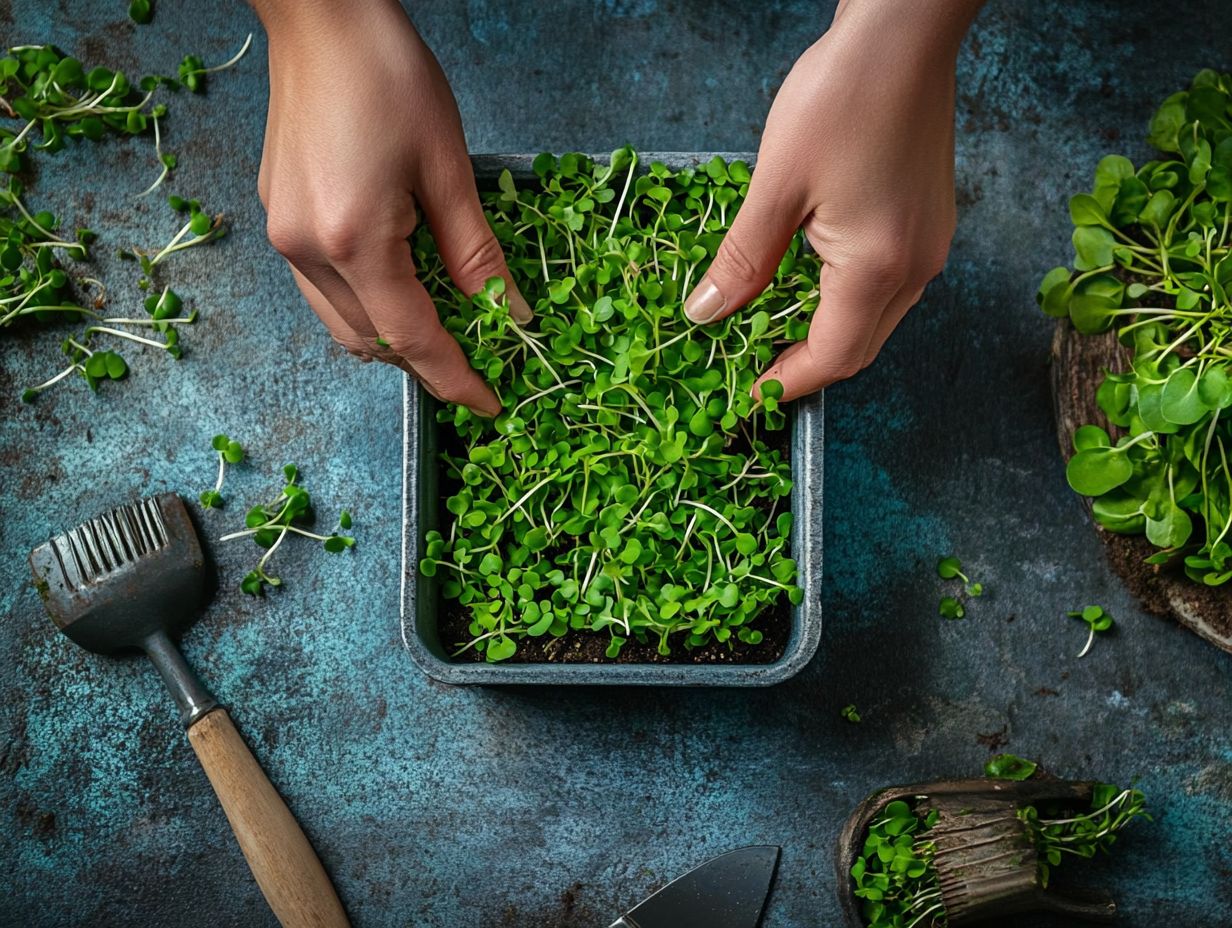
To effectively harvest microgreens, start by gathering your essential tools scissors or sharp shears. Keep your workspace pristine for an efficient process. Identify which microgreens are ripe for picking, then cut just above the soil line to avoid damaging the surrounding plants.
Keep your environment clean during harvesting. Contaminants can compromise the quality of your microgreens. Once you’ve made your cuts, gently transfer your freshly harvested greens into a clean container, ensuring they have enough room to prevent bruising. For the best results, consider timing your microgreens correctly. Rinse the microgreens under cold water, gently agitating them to dislodge any soil or debris.
After washing, lay them flat on a clean towel to dry thoroughly before storage. To keep them fresh, place the dried microgreens in a breathable container inside the refrigerator. Including a damp paper towel in the storage container helps absorb excess moisture, prolonging their crispness.
Remember, precision in your harvest not only enhances quality but also boosts your overall yield.
Maximizing Yield and Quality
Maximizing yield and quality in microgreens cultivation relies on understanding the best ways to harvest, as well as the right growing conditions and expert tips that foster healthy, vigorous growth.
By adopting best practices, you can enjoy bountiful harvests while elevating the flavor and nutritional value of your greens.
Tips for Optimal Harvesting
- Maintain freshness by applying proper techniques during harvesting and ensuring correct storage afterward.
- Pay close attention to timing, cutting methods, and specific storage practices.
- Harvest microgreens when the first true leaves (the second set of leaves that appear) emerge for the best flavor and nutritional content.
- Using sharp scissors for a clean cut prevents damage to the plant, allowing it to regrow if desired.
- Store the greens in a breathable container in the refrigerator, ideally wrapped in a damp paper towel to keep them crisp.
- Routine watering, light adjustments, and soil maintenance throughout the growth period are crucial for high-quality microgreens.
Frequently Asked Questions
How often should I harvest my microgreens?
Harvest your microgreens when they reach about 1-2 inches tall typically within 7-14 days for the best flavor!
Can I harvest my microgreens more than once?

Yes, you can harvest your microgreens more than once. After the initial harvest, the plants will continue to regrow and produce another harvest.
What is the best time of day to harvest microgreens?
The best time to harvest microgreens is in the morning when the plants are well hydrated and nutrient-rich. However, you can harvest them at any time of day.
Wondering when to harvest your microgreens for the best taste?
You can tell when they are ready by their size and appearance. They should be about 1-2 inches tall and have developed their first set of true leaves.
What is the proper way to harvest microgreens?
To harvest microgreens, use clean scissors or a sharp knife to cut the plants just above the soil line. Be sure to rinse and dry them before consuming.
Start your microgreen journey today your taste buds will thank you!
Can I store harvested microgreens?
Absolutely! You can store harvested microgreens in the refrigerator for up to a week.
To keep them fresh, place them in an airtight container or bag with a moist paper towel.


